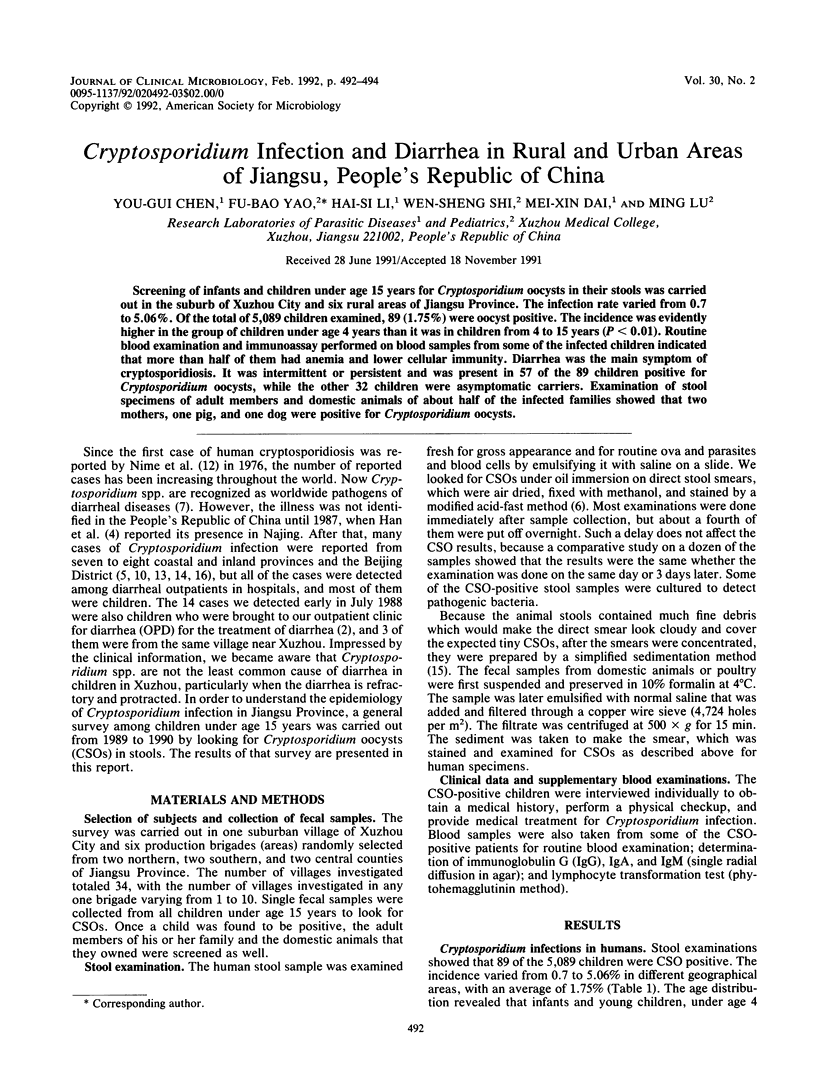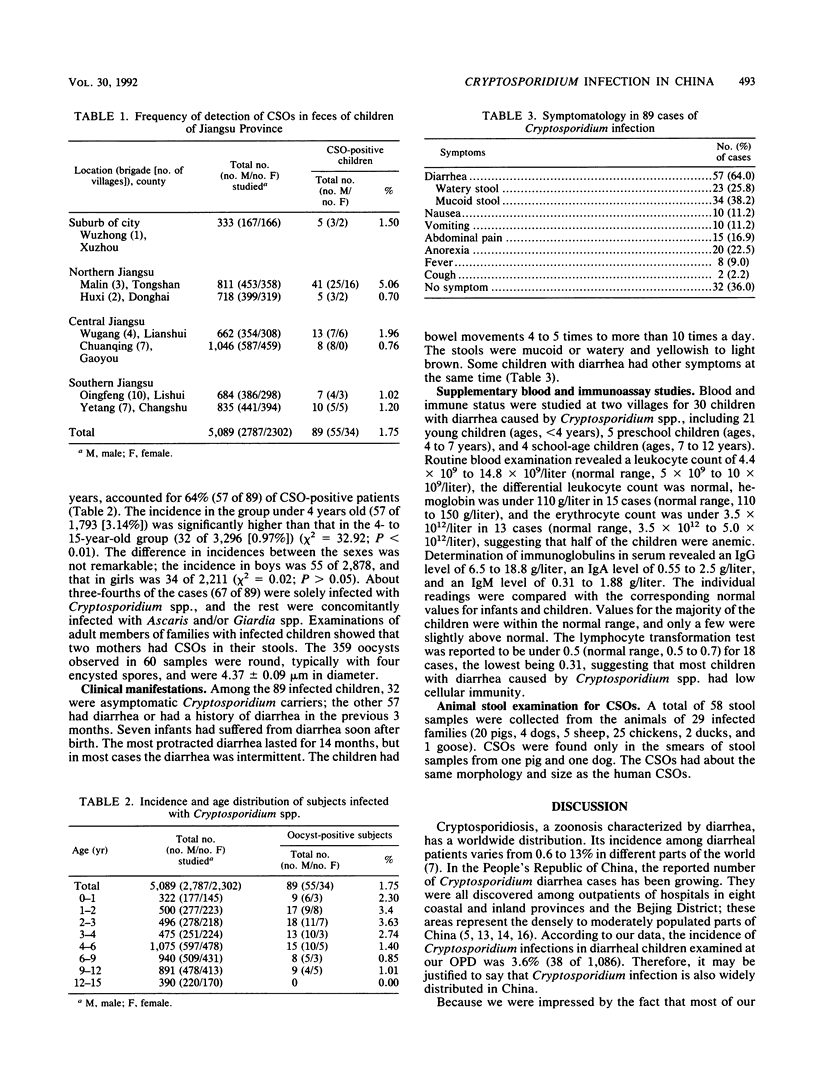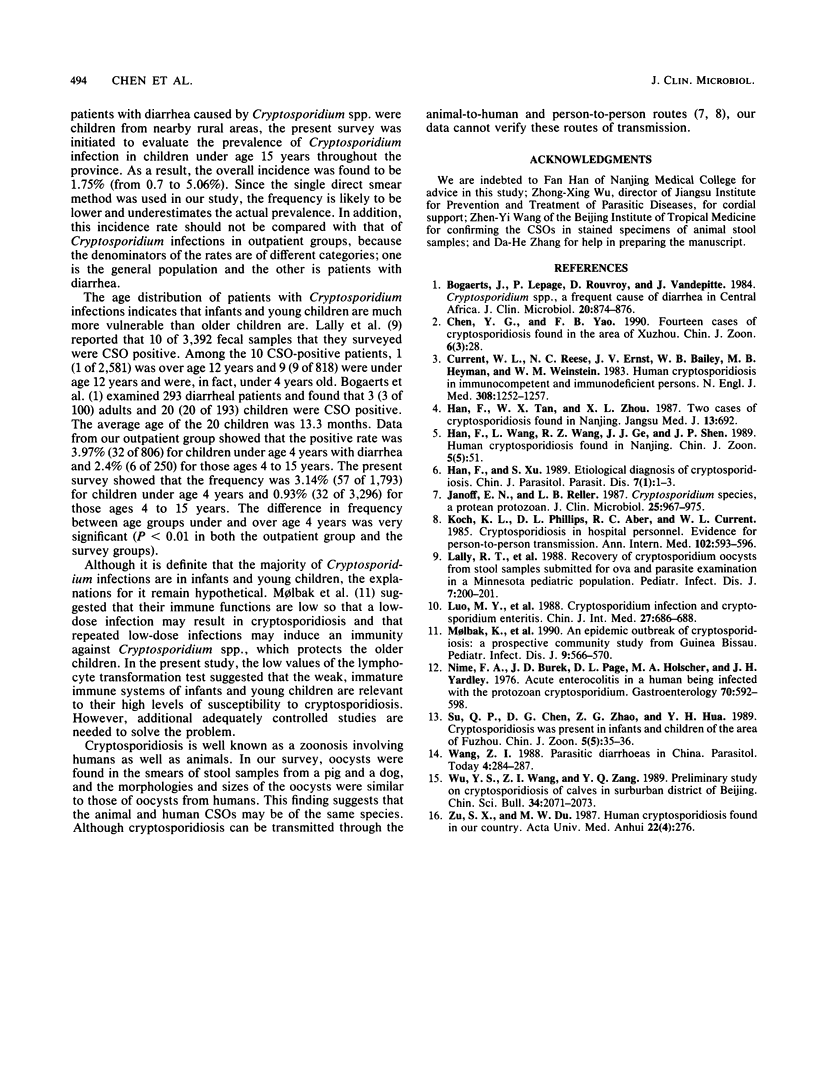Abstract
Screening of infants and children under age 15 years for Cryptosporidium oocysts in their stools was carried out in the suburb of Xuzhou City and six rural areas of Jiangsu Province. The infection rate varied from 0.7 to 5.06%. Of the total of 5,089 children examined, 89 (1.75%) were oocyst positive. The incidence was evidently higher in the group of children under age 4 years than it was in children from 4 to 15 years (P less than 0.01). Routine blood examination and immunoassay performed on blood samples from some of the infected children indicated that more than half of them had anemia and lower cellular immunity. Diarrhea was the main symptom of cryptosporidiosis. It was intermittent or persistent and was present in 57 of the 89 children positive for Cryptosporidium oocysts, while the other 32 children were asymptomatic carriers. Examination of stool specimens of adult members and domestic animals of about half of the infected families showed that two mothers, one pig, and one dog were positive for Cryptosporidium oocysts.
Full text
PDF


Selected References
These references are in PubMed. This may not be the complete list of references from this article.
- Bogaerts J., Lepage P., Rouvroy D., Vandepitte J. Cryptosporidium spp., a frequent cause of diarrhea in Central Africa. J Clin Microbiol. 1984 Nov;20(5):874–876. doi: 10.1128/jcm.20.5.874-876.1984. [DOI] [PMC free article] [PubMed] [Google Scholar]
- Cheng-I W. Parasitic diarrhoeas in China. Parasitol Today. 1988 Oct;4(10):284–287. doi: 10.1016/0169-4758(88)90020-8. [DOI] [PubMed] [Google Scholar]
- Current W. L., Reese N. C., Ernst J. V., Bailey W. S., Heyman M. B., Weinstein W. M. Human cryptosporidiosis in immunocompetent and immunodeficient persons. Studies of an outbreak and experimental transmission. N Engl J Med. 1983 May 26;308(21):1252–1257. doi: 10.1056/NEJM198305263082102. [DOI] [PubMed] [Google Scholar]
- Janoff E. N., Reller L. B. Cryptosporidium species, a protean protozoan. J Clin Microbiol. 1987 Jun;25(6):967–975. doi: 10.1128/jcm.25.6.967-975.1987. [DOI] [PMC free article] [PubMed] [Google Scholar]
- Koch K. L., Phillips D. J., Aber R. C., Current W. L. Cryptosporidiosis in hospital personnel. Evidence for person-to-person transmission. Ann Intern Med. 1985 May;102(5):593–596. doi: 10.7326/0003-4819-102-5-593. [DOI] [PubMed] [Google Scholar]
- Lally R. T., Woolfrey B. F. Recovery of Cryptosporidium oocysts from stool samples submitted for ova and parasite examination in a Minnesota pediatric population. Pediatr Infect Dis J. 1988 Mar;7(3):200–201. doi: 10.1097/00006454-198803000-00013. [DOI] [PubMed] [Google Scholar]
- Luo M. Y., Wang Q. N., Zheng X. P. [Cryptosporidium enteritis and subclinical infection at a department of infectious disease]. Zhonghua Nei Ke Za Zhi. 1988 Nov;27(11):686-8, 717. [PubMed] [Google Scholar]
- Mølbak K., Højlyng N., Ingholt L., Da Silva A. P., Jepsen S., Aaby P. An epidemic outbreak of cryptosporidiosis: a prospective community study from Guinea Bissau. Pediatr Infect Dis J. 1990 Aug;9(8):566–570. doi: 10.1097/00006454-199008000-00008. [DOI] [PubMed] [Google Scholar]
- Nime F. A., Burek J. D., Page D. L., Holscher M. A., Yardley J. H. Acute enterocolitis in a human being infected with the protozoan Cryptosporidium. Gastroenterology. 1976 Apr;70(4):592–598. [PubMed] [Google Scholar]


